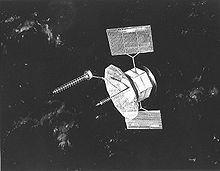FLTSATCOM

FLTSATCOM (also FLTSAT ) was a satellite communication system of the US Navy , which was used for UHF radio connections between ships, submarines, aircraft and ground stations of the American Navy.
A total of eight satellites (six of them successful) were launched into geostationary orbit by Atlas Centaur rockets between 1978 and 1989 . The system became operational in 1981. The satellites were manufactured by TRW . The mass of the first six satellites was 1884 kg, the remaining three 2310 kg. The satellites had a span of 13.2 m across the solar cells. A special feature was a deployable antenna reflector with a diameter of 4.9 m.
The satellites had 12 transponders that worked in the UHF frequency range around 300 megahertz . In addition, FLTSATCOM 6 and 7 also had an experimental transponder in the EHF frequency range in order to test technologies for the later Milstar satellites.
Most of the transponders were simple repeaters that send back all signals without authentication . This resulted especially in Brazil to the emergence of a subculture of radio pirates who are still functioning Fleet Satellite Communications System satellites illegally converted with amateur radio use of Equipment for its own purposes.
Since the late 1990s, the FLTSATCOM satellites have gradually been replaced by the UFO satellites.
Starts
| satellite | Start date | rocket | comment |
|---|---|---|---|
| FLTSATCOM 1 | February 9, 1978 | Atlas-SLV3D Centaur-D1AR | success |
| FLTSATCOM 2 | 4th May 1979 | Atlas-SLV3D Centaur-D1AR | success |
| FLTSATCOM 3 | January 18, 1980 | Atlas-SLV3D Centaur-D1AR | success |
| FLTSATCOM 4 | October 31, 1980 | Atlas-SLV3D Centaur-D1AR | success |
| FLTSATCOM 5 | August 6, 1981 | Atlas-SLV3D Centaur-D1AR | Satellite damaged on launch |
| FLTSATCOM 7 | 5th December 1986 | Atlas-G Centaur-D1AR | success |
| FLTSATCOM 6 | March 27, 1987 | Atlas-G Centaur-D1AR | Missile destroyed by lightning strike |
| FLTSATCOM 8 | September 25, 1989 | Atlas-G Centaur-D1AR | success |
Web links
Individual evidence
- ↑ Marcelo Soares: The Great Brazilian Sat-Hack Crackdown . In: Wired . April 20, 2009. Retrieved April 22, 2009.
